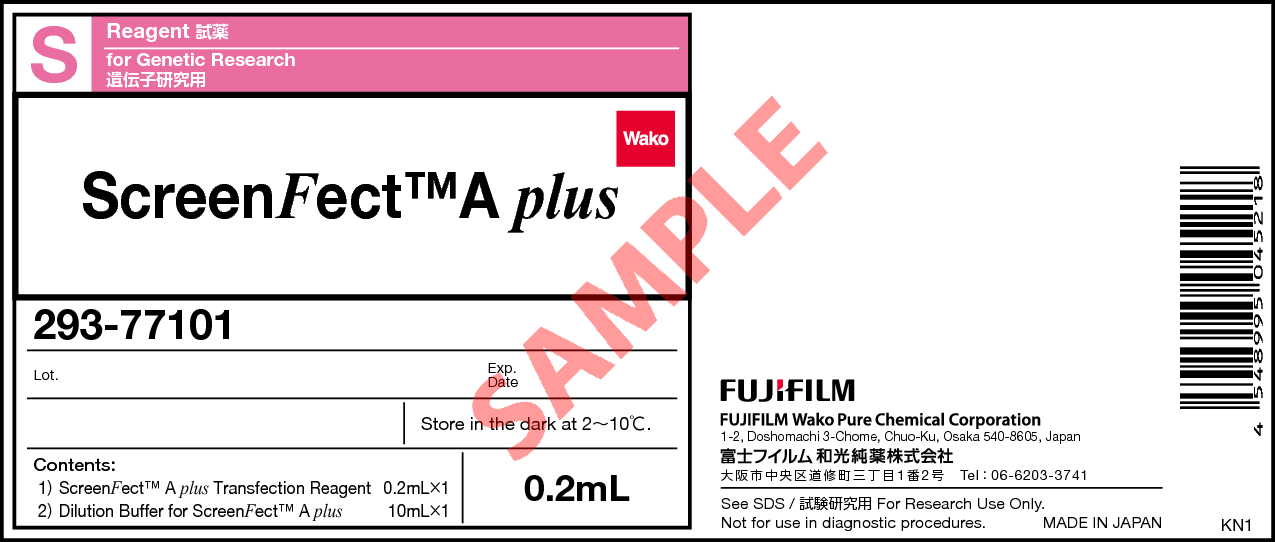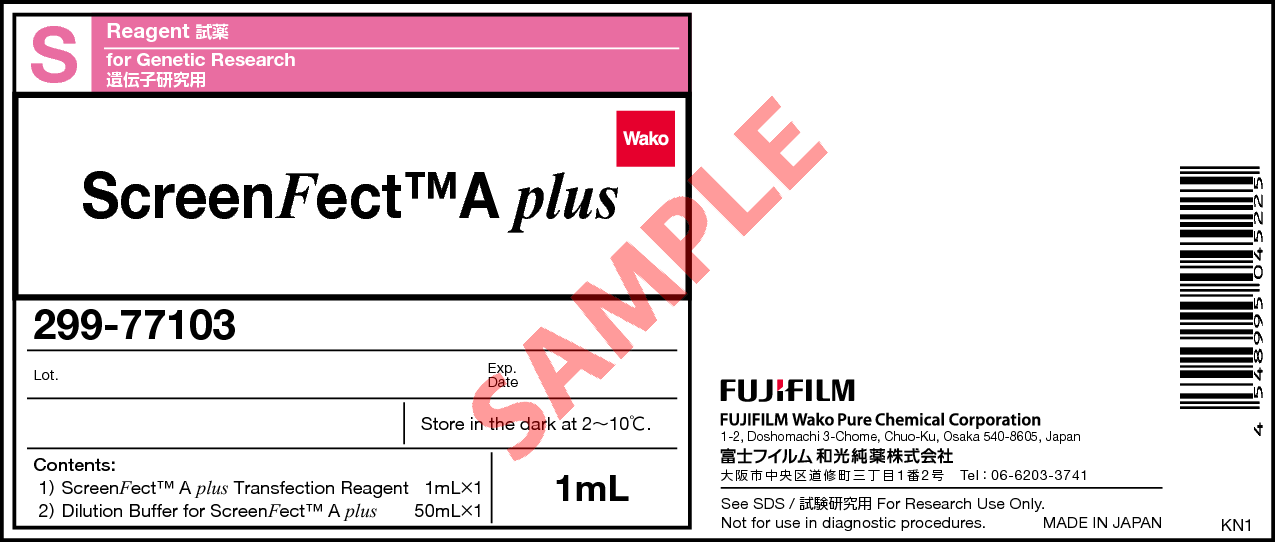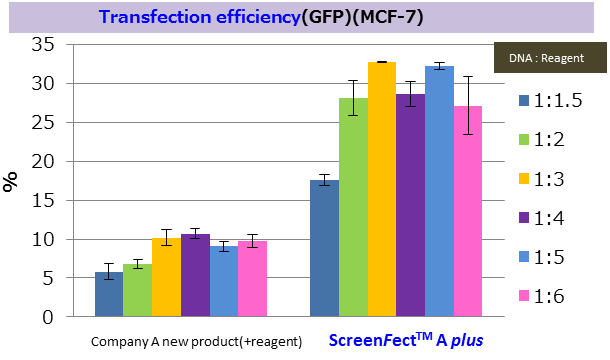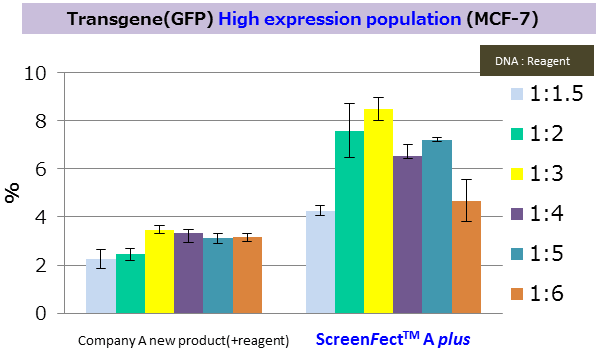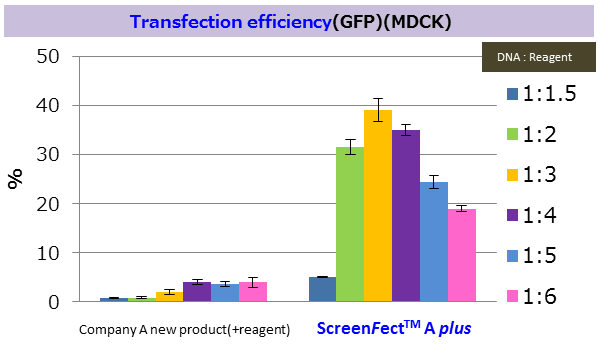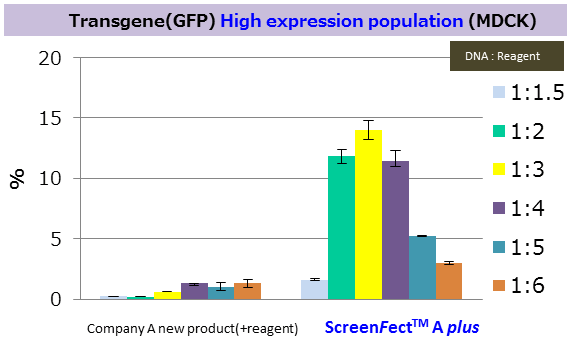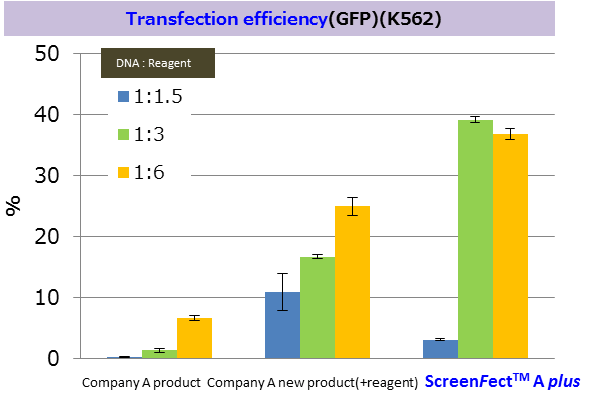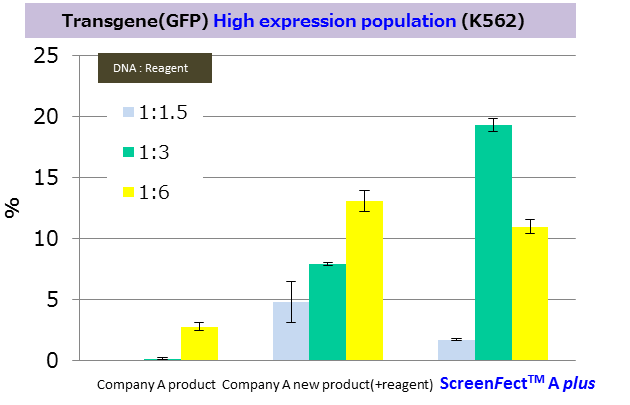ScreenFect(TM)A plus
- for Genetic Research
- Manufacturer :
- FUJIFILM Wako Pure Chemical Corporation
- Storage Condition :
- Keep at 2-10 degrees C.
- Structural Formula
- Label
- Packing
- SDS
|
Comparison
|
Product Number
|
Package Size
|
Price
|
Inventory
|
|
|---|---|---|---|---|---|
|
|
|
0.2mL
|
|
In stock in Japan |
|
|
|
|
1mL
|
|
In stock in Japan |
|
|
|
|
1mL x5
|
|
Discontinued
|
Please check here for notes on products and prices.
Document
Overview
ScreenFect™A plus is a transfection reagent composed of a new cationic loposome screened*1 by click chemistry.
It can be used with various eukaryote-derive cells and can be directly added to medium containing antibodies or serum.
DNA and siRNA can be transfected into general experimental cell strains (HeLa, HepG2, MECK, etc.), stem cells (mouse ES cells, etc.), blood cells (macrophages, THP-1, RAW264.7, etc.), microglia, primary (initial subculture) cells, and insect cells. Medium replacement after transfection is not required due to low cytotoxicity. The constiuent reagents do not contain any poisonous or deleterious substance.
- Broad Range Transfection
- One-step Transfection
- High Transfection Efficiency and Low Toxicity
- Low Running Cost
*1: Biomaterials. Nov., 33 (32): 8160‐6. 2012
Outline of ScreenFect™ A plus Protocol
The 1-Step Protocol is 24 hours faster than 2-Step's.
Comparison of transfection method between 1-Step and 2-Step
| Product | ScreenFect™ A plus | Company A's new product (+ reagent) |
Company A's product |
|---|---|---|---|
| Recommended Protocol | 1-Step | 2-Step | |
| Experiment term | 2 Days | 3 Days | |
| DNA quantity | Low | High | |
| Adjustment of cell numbers | Flexible (cell preparation just before transfection) |
Inflexible (depending on cell pre-culture condition) |
|
| Detachment by trypsin | Required (just before transfection) |
Required (before cell pre-culture) |
|
| Convenience for HTS cell-base assay |
+++++ | + | |
| Medium change | Depending on cell lines | ||
Applications
ScreenFect™A plus Transfection performance
MCF-7 Human breast cancer (adherent)
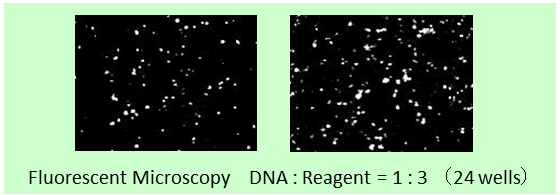
| *MCF-7 | Human breast cancer (adherent) |
| *Protocol | Company A’s new product (+ reagent) → 2-Step ScreenFect™A plus → 1 Step |
➡Effective transfection for difficult-to-transfect cells!

| *MDCK | Madin-Darby canine kidney (adherent) |
| *Protocol | Company A's new product (+ reagent) → 2-Step ScreenFect™A plus → 1 Step |
➡Effective transfection for difficult-to-transfect cells!

| *K562 | Human erythromyeloblastoid leukemia (suspension) |
| *Protocol | Company A's product & the new product (+ reagent) → 2-Step ScreenFect™A plus → 1 Step |
➡Effective transfection for difficult-to-transfect cells!
Experiment of transfecting YFP fusion gene to LNCaP cell (adhesive type)
The experiment of transfection of YFP fusion gene to LNCaP cells (adhesive type) was done, and the expression level of transfected gene was compared by a fluorescence microscope.
Using both ScreenFect™A plus and SFA P-reagent as enhancer reagent, it was demonstrated that the expression efficiency is equal or superior to other competitor’s products.
*Described data in BioWindow No. 144 (published on June, 2016)
In comparison with competitor’s product in the LNCaP cell (human prostatic cancer)
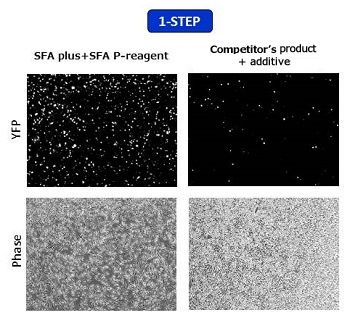
Cell Number 3 x 105 cells/well Amount of Plasmid DNA 1 µg/assay Ratio pDNA (µg): ScreenFect™ A plus reagent(µL) = 1:3 Well Format 24 well plates 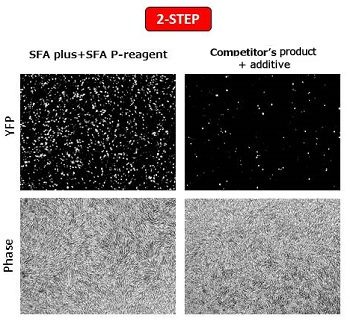
Cell Number 1.5 x 105 cells/well Amount of Plasmid DNA 1 µg/assay Ratio pDNA (µg): ScreenFect™ A plus reagent(µL) = 1:3 Well Format 24 well plates
Experiment of transfecting EGFP_mRNA to HeLa cell (adhesive type)
The experiment of transfection of EGFP_mRNA to HeLa cells (adhesive type) was done, and the expression level of transfected gene was compared by a fluorescence microscope.
Using both ScreenFect™ A plus and SFA P-reagent as enhancer reagent, it was demonstrated that the expression efficiency is equal or superior to other competitor’s products.
*Described data in BioWindow No. 144 (published on June, 2016)
In comparison with competitor’s product in the LNCaP cell (human prostatic cancer)
| Cell Number | 0.7×105 cells/well |
| Amount of mRNA | 0.1 µg/assay |
| Ratio | mRNA(µg): ScreenFect™ A plus reagent(µl) = 1:4 |
| Well Format | 24 well plates |
| Detection Time | 48 hours after transfection |
| Time of Exposure | 2 seconds |
Experiment of transfecting GFP fusion gene to hiPSC (201B7)
The experiment of transfection of GFP fusion gene to hiPSC (201B7) was done by reverse transfection method (1-step) and the expression level of transfected gene was compared by a fluorescence microscope.
Reverse transfection method is the most efficient in transfection into hiPSC(201B7). It was demonstrated that the transfection efficiency with ScreenFect™A plus is equal or superior to competitor’s product in both StemSure hiPSC medium and mTeSR™1 medium.
*Described data in BioWindow No. 144 (published on June, 2016)
In comparison with competitor’s product in the hiPSC(201B7)
Transfection conditions of ScreenFect™ A plus Cell Number 5×105 cells/well Amount of Plasmid DNA 4 µg/assay Ratio pDNA (µg):ScreenFect™ A plus reagent(µL) = 1:0.5 Well Format 12 well plates Note SFA plus reagent and pDNA were diluted by Opti-MEM.
Transfection conditions of competitor's product Cell Number 5×105 cells/well Amount of Plasmid DNA 2 µg/assay Ratio pDNA (µg):ScreenFect™A plus reagent(µL) = 1:2 Well Format 12 well plates
| Transfection conditions of ScreenFect™ A plus and competitor's product | |
|---|---|
| Cell Number | 5×105 cells/well |
| Amount of Plasmid DNA | 1µg/assay |
| Ratio | pDNA (µg):ScreenFect™ A plus reagent(µL) = 1:2 |
| Well Format | 12 well plates |
| Note | SFA plus reagent and pDNA were diluted by Opti-MEM. |
Experiment of tranasfecting PIK3CB siRNA to HeLa cells (adherent cells)
The experiment of transfection of PIK3CB siRNA to HeLa cells was done by both methods of the reverse transfection (1-Step) and the forward transfection (2-Step). The expression quantity of PIK3CB mRNA was measured by real-time quantitative PCR.
Compare the knockdown efficiency from the quantified result against the competitor, ScreenFect™A plus showed knockdown efficiency is equal or superior to the competitor’s product.
Comparisons the pereformance of HeLa cells (adherent cells)
Cell Number 1×105 cells/well Amount of siRNA 5 pmol/assay Amount of Transfection Reagent ScreenFect™ A plus reagent = 0.5 ~ 1.5 μL
Company A's product = 1.5 μLWell Format 24 well plates Detection Time 48 hours after the transfection
Cell Number 0.5×105 cells/well Amount of siRNA 5 pmol/assay Amount of Transfection Reagent ScreenFect™ A plus reagent = 0.5 ~ 1.5 μL
Company A's product = 1.5 μLWell Format 24 well plates Detection Time 48 hours after the transfection
More Information
ScreenFect™ A plus Transfection Condition
| DNA transfection (/well) | |||||
|---|---|---|---|---|---|
| Plate size | Surface area | Medium volume | Total volume SF-DNA complex |
DNA / Dilution Buffer |
Transfection Reagent / Dilution Buffer |
| 96 wells | 0.3 cm2 | 100 µL | 10 µL | 50 ng / 5 μL | 0.15 or 0.2 μL / 5 μL |
| 24 wells | 2 cm2 | 500 µL | 50 µL | 250 ng / 25 μL | 0.75 or 1.0 μL / 25 μL |
| 12 wells | 4 cm2 | 1,000 µL | 100 µL | 500 ng / 50 μL | 1.5 or 2.0 μL / 50 μL |
| 6 wells | 10 cm2 | 2,000 µL | 250 µL | 1,250 ng / 125 μL | 3.75 or 5.0 μL / 125 μL |
Note: For large scale transfections it helps to split sample between several tubes. For example, take 5-6 samples of the 6-well transfection volumes for 10 cm dish transfection.
ScreenFect™ A plus recommended protocol
*Quick protocols are listed in the instructions attached to the actual product. Please access from the following URL or QR code.
The one-step protocol for ScreenFect™A plus transfection is described in the upper part. The optimal DNA-to-reagent-ratio for efficient cell transfection stays constant at around 1:3 to 1:4 and we recommend splitting cells when they reach 60% ~ 80% confluence to avoid contact inhibition of cell proliferation.
| siRNA transfection (/well) | |||||
|---|---|---|---|---|---|
| Plate size | Surface area | Medium volume | Total volume SF-siRNA complex |
siRNA / Dilution Buffer |
Transfection Reagent / Dilution Buffer |
| 96 wells | 0.3 cm2 | 100 µL | 10 µL | 1 pmol / 5 µL | 0.1~0.3 µL / 5 µL |
| 24 wells | 2 cm2 | 500 µL | 50 µL | 5 pmol / 25 µL | 0.5~1.5 µL / 25 µL |
| 12 wells | 4 cm2 | 1,000 µL | 100 µL | 10 pmol / 50 µL | 1.0~3 µL / 50 µL |
| 6 wells | 10 cm2 | 2,000 µL | 250 µL | 25 pmol / 125 µL | 2.5~7.5 µL / 125 µL |
List of Cells transfected by ScreenFect™ A or A plus
|
|
FUJIFILM Wako Pure Chemical Corporation is updating constantly the ScreenFect™ Databese.
If you are not sure whether it is applicable to cells other than listed above, feel free to ask us.
References
- Diefenbacher, Markus E., et al. "The LIM Domain Protein nTRIP6 Recruits the Mediator Complex to AP-1-Regulated Promoters." PLoS ONE 9.5 (2014): e97549.
- Freise, Christian, and Uwe Querfeld. "Inhibition of vascular calcification by block of intermediate conductance calcium-activated potassium channels with TRAM-34." Pharmacological Research (2014).
- Hagiwara, Akane, et al. "Luteinizing Hormone-Induced Expression of Ptger4b, a Prostaglandin E2 Receptor Indispensable for Ovulation of the Medaka Oryzias latipes, Is Regulated by a Genomic Mechanism Involving Nuclear Progestin Receptor."
- Peng, Yanyan, Ruidan Xu, and Xiaofeng Zheng. "HSCARG Negatively Regulates the Cellular Antiviral RIG-I Like Receptor Signaling Pathway by Inhibiting TRAF3 Ubiquitination via Recruiting OTUB1." PLoS pathogens 10.4 (2014): e1004041. (3)
- Wakimoto, Hiroaki, et al. "Targetable signaling pathway mutations are associated with malignant phenotype in IDH-mutant gliomas." Clinical Cancer Research (2014). (2)
- Fischer, Simon, et al. "Breaking limitations of complex culture media: Functional non-viral miRNA delivery into pharmaceutical production cell lines." Journal of biotechnology 168.4 (2013): 589-600.
- Bai, Dongmei, et al. "Regulation of the HDM2-p53 pathway by ribosomal protein L6 in response to ribosomal stress." Nucleic acids research 42.3 (2014): 1799-1811.
- Liu, Xing, et al. "Isocitrate dehydrogenase 2 mutation is a frequent event in osteosarcoma detected by a multi‐specific monoclonal antibody MsMab‐1." Cancer medicine 2.6 (2013): 803-814.
Overview / Applications
| Outline | This product is for research use only. Do not administer it to human. ScreenFect (TM) A plus is a transfection reagent consisting of a new cationic liposome screened by click chemistry. |
|---|
Property
Manufacturer Information
Alias
- Transfection Reagent
Transfection Reagent
ScreenFectTMA plus
For research use or further manufacturing use only. Not for use in diagnostic procedures.
Product content may differ from the actual image due to minor specification changes etc.
If the revision of product standards and packaging standards has been made, there is a case where the actual product specifications and images are different.
The prices are list prices in Japan.Please contact your local distributor for your retail price in your region.




